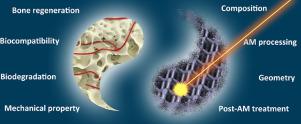Acta Biomaterialia ( IF 9.4 ) Pub Date : 2020-08-25 , DOI: 10.1016/j.actbio.2020.08.018 Yageng Li 1 , Holger Jahr 2 , Jie Zhou 1 , Amir Abbas Zadpoor 1

|
Partially due to the unavailability of ideal bone substitutes, the treatment of large bony defects remains one of the most important challenges of orthopedic surgery. Additively manufactured (AM) biodegradable porous metals that have emerged since 2018 provide unprecedented opportunities for fulfilling the requirements of an ideal bone implant. First, the multi-scale geometry of these implants can be customized to mimic the human bone in terms of both micro-architecture and mechanical properties. Second, a porous structure with interconnected pores possesses a large surface area, which is favorable for the adhesion and proliferation of cells and, thus, bony ingrowth. Finally, the freeform geometrical design of such biomaterials could be exploited to adjust their biodegradation behavior so as to maintain the structural integrity of the implant during the healing process while ensuring that the implant disappears afterwards, paving the way for full bone regeneration. While the AM biodegradable porous metals that have been studied so far have shown many unique properties as compared to their solid counterparts, the unprecedented degree of flexibility in their geometrical design has not yet been fully exploited to optimize their properties and performance. In order to develop the ideal bone implants, it is important to take advantage of the full potential of AM biodegradable porous metals through detailed and systematic study on their biodegradation behavior, mechanical properties, biocompatibility, and bone regeneration performance. This review paper presents the state of the art in AM biodegradable porous metals and is focused on the effects of material type, processing, geometrical design, and post-AM treatments on the mechanical properties, biodegradation behavior, in vitro biocompatibility, and in vivo bone regeneration performance of AM porous Mg, Fe, and Zn as well as their alloys. We also identify a number of knowledge gaps and the challenges encountered in adopting AM biodegradable porous metals for orthopedic applications and suggest some promising areas for future research.
中文翻译:

增材制造的可生物降解的多孔金属。
部分由于缺乏理想的骨替代品,大骨缺损的治疗仍然是整形外科最重要的挑战之一。自2018年以来出现的可增材制造(AM)可生物降解多孔金属为满足理想骨植入物的要求提供了前所未有的机会。首先,可以定制这些植入物的多尺度几何形状,以在微观结构和机械特性方面模仿人体骨骼。第二,具有相互连通的孔的多孔结构具有较大的表面积,这有利于细胞的粘附和增殖,从而有利于骨向内生长。最后,可以利用这种生物材料的自由形式的几何设计来调整其生物降解行为,以便在愈合过程中维持植入物的结构完整性,同时确保植入物随后消失,为全骨再生铺平道路。尽管到目前为止已研究的AM可生物降解多孔金属与固态金属相比显示出许多独特的性能,但其几何设计中前所未有的灵活性尚未得到充分利用以优化其性能和性能。为了开发出理想的骨植入物,重要的是通过对AM生物可降解多孔金属的生物降解行为,力学性能,生物相容性,和骨骼再生性能。这篇评论文章介绍了AM可生物降解多孔金属的最新技术,并重点研究了材料类型,加工,几何设计和AM后处理对机械性能,生物降解行为,AM多孔Mg,Fe和Zn及其合金的体外生物相容性和体内骨再生性能。我们还确定了在骨科应用中采用AM可生物降解多孔金属在骨科应用中所面临的许多知识差距和挑战,并提出了一些有希望的未来研究领域。











































 京公网安备 11010802027423号
京公网安备 11010802027423号